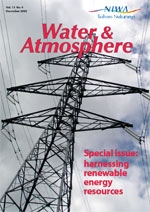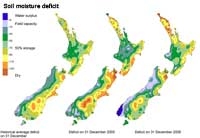PDF of this article (105 KB)


Jim Renwick is one of NIWA’s climate scientists, based in Wellington. When we spoke to Jim last month, he had just returned from Antarctica. Swapping survival suit for dinner jacket, he received a prize at the Royal Society’s formal awards dinner – the Meteorological Society’s Kidson Medal for the outstanding scientific paper on a weather/climate topic. Jim’s paper was on links between Antarctic sea ice and El Niño.
W&A – You're saying the climate in the tropics affects Antarctica?
Jim – El Niño and La Niña are driven by the tropical Pacific Ocean, and their influence extends outward from there. Ten years ago, no one thought El Niño could affect Antarctica, but it does. During El Niño years, we see more big highs staying longer over the southeast Pacific. The result is less sea ice in the South Pacific but more in the Weddell Sea and South Atlantic.
This year, I got a grant from the Marsden Fund to look at links between El Niño and the ozone hole. I think El Niño may help explain why the ozone hole breaks up really early sometimes, because El Niño affects the westerly winds which keep the hole in place.
W&A – With climate change, what will life be like here in 50 years' time?
Jim – New Zealand’s climate will probably get a bit harsher: the winds will get stronger, wet areas will get wetter, dry areas will get drier. It won't happen overnight and farmers will adapt. For city dwellers, energy will be the big issue (see Jim’s article on climate variability). We'll want more electricity than now to cool our houses in summer and less to heat them in winter, but maybe the lake levels will be more constant, which would be good news.
W&A – How did you get interested in science?
Jim – I grew up in Springfield, 60 km west of Christchurch. According to publications at the time, the town had a population of 337. Partway through primary school, we got a new headmaster, Mr Bird, from the Bay of Islands. He bought some chemistry gear and weather-observing tools, and that really got me interested. At secondary school I took maths, physics, and chemistry. During my maths degree at Canterbury University, I discovered I really enjoyed fluid mechanics, which is important for studying the weather and climate.
W&A – How can the air be a fluid?
Jim – A fluid is simply any substance that flows, so gases can act as fluids. The wind is a fluid flow, moving heat from the tropics towards the poles.
W&A – You started out as a weatherman?
Jim – I was recruited into the MetService. After a year of training, I worked on aviation and marine forecasts. I'd read my forecasts live on National Radio at 4 am for boaties. The forecasts were very formal because they are so important for safety. The aviation ones were also very specific, and had to be updated at least every 3-4 hours. You had to forecast wind speed and direction, the height of each cloud layer, the amount of cloud in each layer, precipitation, and visibility. You'd be doing 20-30 airport forecasts several times over on your shift.
The group I was with at the MetService also did research. I did a Masters part-time at Vic, then went to the US for my PhD. While I was there, during the restructuring of the early 90s, our MetService group joined NIWA.
W&A – What’s the farthest out you've ever had to forecast?
Jim – At NIWA, I help produce the seasonal climate outlooks. If you think it’s hard to forecast tomorrow’s weather, try predicting the climate over the next three months! I once forecast the weather for New Year’s Day 3000 for a newspaper’s millennium (Y2K) special.
Jim's short forecast for all of New Zealand to midnight, 1 January 3000
A warm start to the new Millenium, with temperatures expected to be in the mid-30s over much of New Zealand, and reaching into the 40s again in Canterbury and Otago, with northwesterly winds in the south. Very heavy rain is likely again in south Westland and Fiordland, with up to 1000 mm possible in places. Banana plantations in the central North Island should experience good growing conditions through the rest of this week, but heavy afternoon showers will bring a chance of local flash flooding. Northland Island (the region north of the Manukau-Waitemata Straits) should experience rising easterly winds, as Tropical Cyclone Helen approaches from the north.
Here’s the full reference for Jim’s prize-winning article. The medal is awarded by the New Zealand Meteorological Society to the author of an outstanding paper published in a refereed scientific journal during the preceding three years.
Renwick, J.A. (2002). Southern Hemisphere circulation and relations with sea ice and sea surface temperature. Journal of Climate 15: 3058-3068.
